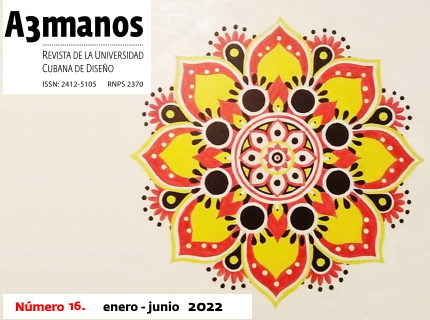Aesthetics of sustainability.
##plugins.themes.bootstrap3.article.main##
Abstract
Philosophy of design can draw on insights from other fields of philosophy, like ancient Greek and Chinese philosophy. Ancient philosophies offer a new insight to a more general philosophy of design that can be put to use in contemporary design practice, leading us toward improved design methods for the creation of a more ethical society. The Chinese concept of “Effortless Action”, based on finding the real needs and avoiding the struggle to produce what is not necessary, appears to be a surprising fit for our contemporary society in search for answers to the problems created by the lack of sustainability in our production and consumption models and methods.
##plugins.themes.bootstrap3.article.details##

This work is licensed under a Creative Commons Attribution-NonCommercial-ShareAlike 4.0 International License.
- Attribution — You must give appropriate credit , provide a link to the license, and indicate if changes were made . You may do so in any reasonable manner, but not in any way that suggests the licensor endorses you or your use.
- NonCommercial — You may not use the material for commercial purposes .
- No additional restrictions — You may not apply legal terms or technological measures that legally restrict others from doing anything the license permits.
- ShareAlike — If you remix, transform, or build upon the material, you must distribute your contribution under the same license as the original. NOTE: This point applies to numbers 1 to 20 of the magazine with the previous CC-BY-NC-SA 4.0 license. Does not apply to the new CC BY-NC 4.0 license from Volume 11, Number. 21 (2024).
References
-The two virtues of thought that deal with what can be otherwise, i.e., what is contingent, are technê and phronêsis, craft and practical wisdom. Aristotle emphasizes the former, a disposition (hexis) with respect to making (poiêsis), is distinct from the latter, a disposition with respect to doing (praxis). https://plato.stanford.edu/entries/episteme-techne/
-Sinologist Jean François Billeter born 1939 in Basel, Switzerland; is a Swiss sinologist and honorary professor of the University of Geneva, where he created the sinology department in 1987.
-Author: Jean François Billeter. Year of publication: 1990. Title: Chinese Art of Writing. Publisher: Rizzoli.
-WuWei, (Chinese: “non-action”; literally, “no action”) Wade-Giles romanization wu-wei, in Chinese philosophy, and particularly among the 4th- and 3rd-century-BCE philosophers of early Daoism (daojia), the practice of taking no action that is not in accord with the natural course of the universe. https://www.britannica.com/topic/wuwei-Chinese-philosophy
-Information
Author: R. M. Dancy. Year of publication: 2004. Title: Plato's Introduction of Forms. Publisher: Cambridge University Press.
-“Aristotle conceived of Poiesis as ranging over what might be in order to create a high-level product of the human intellect for reflection and the development of character. “ (Thomas Martin, Department of English, Wheaton College. https://doi.org/10.1093/acrefore/9780190201098.013.1080 Published online: 31 March 2020.
-“Episteme and Techne”, Stanford Encyclopedia of Philosophy. First published Fri Apr 11, 2003; substantive revision Fri Mar 27, 2020.
-Author: Andrea Branzi. Year of publication: 2018. Title: “Il Design, Storia e Controstoria“. Publisher: Giunti Editore.
-Telos: "an ultimate end”. Merriam-Webster vocabulary. https://www.merriam-webster.com/dictionary/telos
-“Telos or Teleute’”. Author: Werner Jaeger. Year of publication: 1986. Title: “Paideia: The Ideals of Greek Culture”. Publisher: Oxford University Press. Pag.69.
-Author: Kamran, Qeis, Topp, Saskia, Henseler, Jörg. Year of publication: 2021. Title: Towards the Co-evolution of Food Experience Search Spaces Based on the Design Weltanschauung Model in Food Marketing”. Publisher: Cogent Business & Management.
- The word comes from the Greek `aisthetikos', meaning `of sense perception.’University of Sussex, Generative Creativity - lecture 14.
-https://www.merriam-webster.com/dictionary/ethos
-https://www.merriam-webster.com/dictionary/kalon
-“Plato’s thymos represents a pared-down model of human agency typified by one central desire or aim in life but also exhibiting whatever further capacities of persons are necessary to enable it to pursue that aim in interaction with the other elements of the personality.” https://oxfordre.com/classics/view/10.1093/acrefore/9780199381135.001.0001/acrefore-9780199381135-e-8180?rskey=sInAOt&result=1
Thymos, by Douglas Cairns https://doi.org/10.1093/acrefore/9780199381135.013.8180
-The Brionvega “Cube” is a global icon of industrial design and as such is on display in the most important contemporary art museums of the world. It can be found, for example, at New York’s MoMA. https://www.brionvega.it/es/radio-cubo.html
-“Valentine” Portable Typewriter. Artist: Ettore Sottsass (Italian (born Austria), Innsbruck 1917–2007 Milan). Manufacturer: Ing. C. Olivetti & C. S.p.A., Ivrea, Italy. Date: 1968. https://www.metmuseum.org/art/collection/search/739409
-The Critique of Judgment (Kritik der Urteilskraft), also translated as the Critique of the Power of Judgment, is a 1790 book by the German philosopher Immanuel Kant.
- Author: Huang Yushun, Li Xuening, Prof. Yushun Huang, Meirong Yan, Prof. Xuening Li.Year of publication: 2021. Title: “Life Confucianism as A New Philosophy: Love and Thought. Publisher: Bridge21 Publications.
-https://www.epa.gov/climateleadership/sector-spotlight-electronics
-Author: Serge Latouche. Year of publication: 2019. Title: “La décroissance: Que sais-je ? n° 4134”. Publisher: Presses Universitaires de France.
-Journal Article. Title: “Décroissance: A Project for a Radical Transformation of Society”. Author: Barbara Muraca. Environmental Values. Vol. 22, No. 2, special issue: Degrowth (April 2013), pp. 147-169. Publisher: White Horse Press
-Author: Christy Bartlett, Dr. Charly Iten, Prof. James-Henry Holland. Title: “Flickwerk: The Aesthetics of Mended Japanese Ceramics”. Publisher: Cornell University, H. Johnson Museum of Art.
























